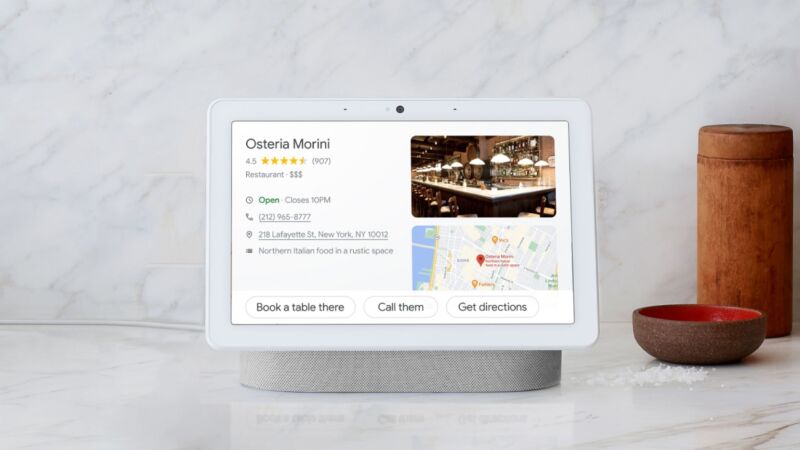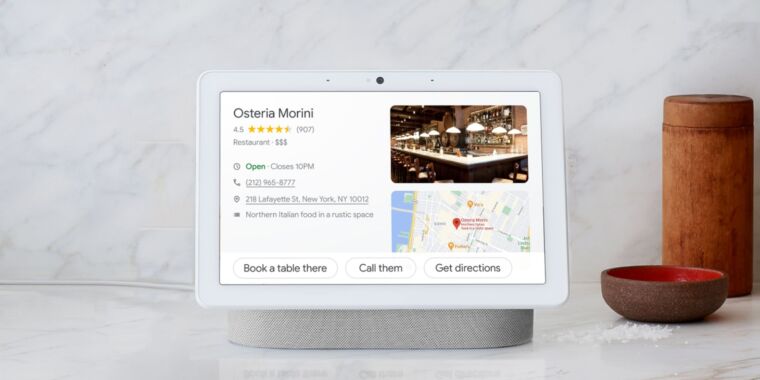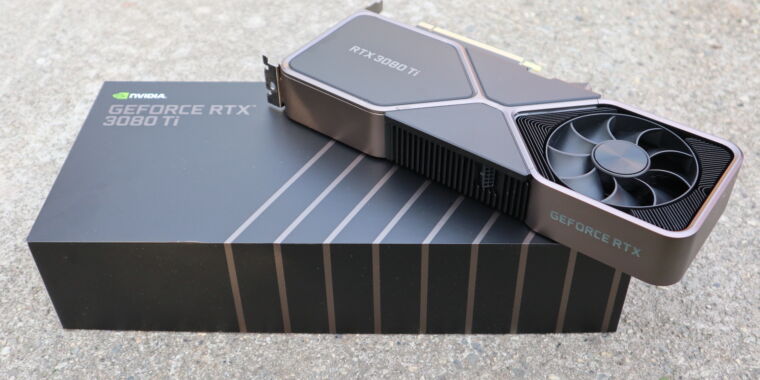
The kingdom of Google’s third major operating system, Fuchsia, is growing a little wider today. 9to5Google reports Google completed the rollout of Fuchsia to the Google Nest Hub Max. Along with the original Nest Hub/Google Home Hub, that puts two of Google’s three smart displays on the new OS, with the one holdout being the 2nd Gen Nest Hub. The Nest Hub Max is the first device running Fuchsia that Google is currently selling—the Home Hub only got Fuchsia after it had been discontinued.
The Google smart display user interface is written in Flutter, a Google programming language designed for portability, which runs on Android, iOS, Fuchsia, and the weird cast platform Nest Hubs typically use. So it’s not right to describe the user interface as “similar” after the OS swap—it’s the exact same code because Flutter runs on nearly everything. You are getting a slightly newer code version, though, and it comes with a Bluetooth menu. If you dive into the settings and hit “about device,” you’ll see a “Fuchsia Version” field that will say something like “6.20211109.1.3166243.”
It’s a bit weird to do an entire OS switch to the futuristic, secretive Fuchsia project and then have basically nothing to show (or say) for it in terms of obvious improvements in performance or security. You can dive into the minutia of the Fuchsia source code, but it continues to be a mystery in terms of what practical benefits it offers consumers. Google never talks about Fuchsia, so not much is known about what, exactly, Google is accomplishing here.
Smart displays find a good home
Part of this OS switch might just be out of necessity. Google’s smart displays haven’t historically had a strong OS foundation inside the company, so maybe Fuchsia represents a way for smart displays to get on board with a viable Google platform. The first Google Smart Displays were from third-party manufacturers, and they ran Android Things, a stripped-down version of Android designed for IoT devices and smart displays. Android Things was shut down in early 2021, so that’s not an option for smart displays anymore.
Google’s in-house smart displays made the strange decision to run an offshoot of the Google Cast platform, an OS originally developed for the Chromecast. Building full touchscreen interaction and an entire UI into the Cast OS was a massive change for something that previously was only a video and slideshow receiver, but that’s the plan that Google went with. When the actual Chromecast line needed to undergo a similarly dramatic change with an entire UI, it didn’t upgrade its own Cast OS and instead switched to Android TV (now called Google TV).
Does the Cast OS have a future at Google? It doesn’t seem like the product’s original hardware, the Chromecast, will want much to do with it in the future. If Google wants to be competitive with Roku, then that means even the cheapest Chromecast needs to run full Android TV and have a remote control. Android TV still has all the simplicity benefits of a Chromecast—you can just fire off media to it with a single phone button press, but it also adds installable media apps and games. If the Chromecast abandons its namesake OS, then the only thing propping up Cast OS will be smart speakers. Cast OS might die entirely, or it might be scaled down to only be a zero UI, embedded OS for smart speakers.
Fuchsia is interesting because it’s one of the few OSes that isn’t based on Linux. The kernel is called “Zircon,” and the Fuchsia project describes itself as “a new open source operating system created at Google from the kernel up to meet the needs of today’s growing ecosystem of connected devices.” Fuchsia originally claimed it would someday run on smart displays, speakers, laptops, and smartphones, but as demonstrated above, the roadmap of OSes at the margins of Google can change very frequently. It’s hard to imagine any project unseating Android or Chrome OS, but Google’s not afraid of product duplication.








